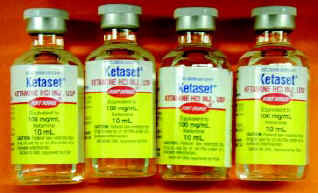Red Flags with Spravato

Spravato (esketamine) was approved as a fast-acting antidepressant for treatment-resistant depression in March 2019. There were several problems with the FDA’s approval of the drug, including the price—nearly $900 per dose, the acceptance of a withdrawal study for the needed second positive clinical trial, and the fact that it carries a boxed warning that cautions patients are at risk of “suicidal thoughts and behaviors after administration of the drug.” And like ketamine, it is a Schedule III controlled substance, putting patients at risk for abuse and misuse. It seems Spravato needs some positive spin to win a patient population.
Dr. John Miller obliged, writing an article for Psychiatric Times, “Depression’s Journey From Monoamines to Glutamate.” He traced the history of ketamine as a racemic mixture, meaning it has an equal mixture of esketamine and arketamine. Janssen developed its intranasal spray with esketamine and named this new molecular entity Spravato. The so-called “paradigm shift” of depression treatment with ketamine acting on the NMDA glutamate receptor, and appearing to reduce depressive symptoms within 72 hours, was contrasted with the older, traditional monamine hypothesis of depression that would take weeks. All other FDA-approved antidepressants before Spravato act on the monoamine system.
Dr. Miller then guided his readers through a review of the two positive clinical trials submitted to the FDA for approval of Spravato. There were actually five phase 3 clinical trials, meaning Spravato failed to demonstrate statistical significance in three of the five clinical trials. Nevertheless, he saw Spravato as crossing into “a new paradigm of TRD [treatment resistant depression].” He hoped esketamine was the first of “a long list of non-monoamine-based treatments to help improve the lives and functioning of the many individuals suffering from TRD.” By the way, Dr. Miller is on Janssen’s Advisory Board as well as the Speaker’s Bureau for Spravato.
Another study by Daly et al, “Efficacy and Safety of intranasal Esketamine Adjunctive to Oral Antidepressant Therapy in Treatment-Resistant Depression” found a “clinically meaningful treatment effect” versus placebo. The antidepressant response was rapid and dose related. It seemed to persist for more than 2 months with a lower dosing frequency. Jodi Rintelman reviewed the study for The Mental Elf, and said it gave hope for a fast-acting antidepressant. Depression scores showed statistical improvement in seven days. “That’s a huge improvement over SSRIs, which can take 4 to 8 weeks to show significant improvement in mood.”
CEP (Council for Evidence-Based Psychiatry) pointed out on Twitter how the Mental Elf article initially failed to note that eight of the study’s authors were Janssen employees. In the comments section to the blog, Andre Tomlin then cited two paragraphs quoted below that appeared in the blog article afterwards. The first was added to the Strengths and Limitations section and the second was in the Implications for Practice section.
The authors also may have a vested interest in Spravato’s commercial success. Renaissance Pharmaceuticals, LLC is manufacturing Spravato for Janssen Pharmaceuticals, Inc. Eight of the authors, including the lead author, work for Janssen Research & Development and hold stock in the company. As the U. S. Food and Drug Administration continues to provide less money for drug development, drug companies are picking up the slack. The impact of this funding trend on our patients is not yet known.
It’s important to note that while no deaths were reported in this trial, in the trials reported to the FDA for consideration, there were six deaths in the treatment arms. While none of the deaths were proven to be drug-related, three people died from suicide, one from a motorcycle accident, one had a heart attack, and the sixth person likely died as a result of complications from hypertension and obesity.
Then Bloomberg reported President Trump offered to help the Department of Veterans Affairs to negotiate the acquisition of Spravato, saying he had “really read quite a bit” about the drug and believed it could help reduce the suicide rates of veterans. He told the Veteran Affairs Secretary, Robert Wilkie, he thought Johnson & Johnson (the parent company of Janssen) would be very generous to the VA. The President said:
Give it to anybody that has the problem, because you have people calling and our folks do a great job on the phone — but it’s a telephone. . . . You have people calling for help and if those people had that, I’m hearing like instantaneously they’re in better shape.
Wilkie acknowledged the medicine was “very effective” and hoped Spravato would have the drug in all VA hospitals by the end of the year. But concern that the President’s remarks were contributing to a rushed approval by the VA, led Mark Takano, the Chairman of the House Committee on Veterans’ Affairs, to say:
I am incredibly alarmed by reporting today that suggests Spravato, a controversial new drug, is being rushed through critical reviews and may be prescribed to veterans before fully vetting the potential risks and benefits.
Already, many concerns have been raised about the drug’s safety and efficacy, its suspicious fast-track approval through FDA review, and VA’s contracting process. Today’s reporting raises additional concerns that VA’s own process for objective review is being undercut by undue influences. Questions remain about the ultimate impact on the health and safety of veterans, who should not be made into a “test case” while the clinical community continues to gather data about this treatment.
We demand that VA provide documents and information about its review and contracting process to adequately address critical questions—including whether VA officials were pressured by the White House or the Mar-a-Lago “three” to prescribe this drug to veterans. Spravato should not be added to VA’s formulary until we have more answers about what this means for our nation’s veterans.
The VA announced that it would offer Spravato for treatment-resistant depression, but would not include it on the VA’s formulary, meaning doctors need prior approval before prescribing and buying the medication for patients. A VA spokesperson said VA psychiatrists could offer Spravato “when clinically indicated,” but would have to keep “with the FDA-approved indications for esketamine use and safety requirements.” Susan Carter, the VA’s director of media relations said the VA will closely monitor the drug’s use and effectiveness and compare it with other treatments. Mark Takano said he asked the VA to provide documents and information to ensure the VA was not “pressured by the White House” to prescribe Spravato to veterans. Takano said: “Spravato should not be added to VA’s formulary until we have more answers about what this means for our nation’s veterans.”
Three psychiatrists, including one who is a therapist for the MAPS Clinical Study of MDMA-Assisted Psychotherapy for PTSD, wrote an opinion article for Vice, “The New Ketamine-Based Antidepressant Is a Rip-Off.” They pointed out where esketamine was no better than placebo in two of the three short-term Phase III trials submitted to the FDA for approval. Yet they thought the problems with the drug weren’t the biggest concern. Spravato (esketamine) is just a way for “Johnson & Johnson to make a significant profit off gullible insurance companies and vulnerable patients.”
Ordinary ketamine is a racemic medication, meaning it is made up of two molecules that are mirror images of each other. Because ordinary ketamine is generic, Johnson & Johnson simply isolated one of the two molecules in regular ketamine so that it qualified as “new.” The reality is that we don’t know whether esketamine is more or less effective than regular ketamine because there have been no head-to-head trials between the two. Johnson & Johnson only tested esketamine against a placebo, likely because they feared esketamine might actually perform worse than the generic version.
Kaiser Health News described a series of red flags overlooked by the FDA with Spravato. There was only modest evidence of its effectiveness and then only in limited trials. Janssen provided no information on the safety of Spravato for long-term use beyond 60 weeks. And as noted above, there were three patients who died by suicide during clinical trials. Facing political pressure to rapidly bring drugs treating life-threatening conditions to market, the FDA endorsed it anyway.
Some deep misgivings were expressed by members of the FDA advisory board in its day-long review meeting. Dr. Jess Fiedorowicz, a member of the advisory committee and the director of the Mood Disorders Center at the University of Iowa, said Spravato’s benefit was “almost certainly exaggerated.” He was surprised by the vote, which was strongly in favor of the drug. The approval process for esketamine (Spravato) shows how drug makers take advantage of several steps in the FDA approval process to bring a potentially lucrative drug to market.
The first Step was taken in 2013 when Janssen was able to get the FDA to approve esketamine as a “breakthrough therapy” for it potential to rapidly reverse depression. This is a holy grail for suicidal patients, especially those found in emergency rooms. That potential was based upon a two-day study with 30 patients being given esketamine intravenously. This “breakthrough therapy’ status placed esketamine in a fast track for approval, with more frequent input from the FDA.
The second Step in the process occurred during discussions between FDA regulators and Janssen regarding the amount and quality of evidence required by the agency. With regard to Spravato, questions were raised about how many drugs must fail before a patient’s depression in considered “treatment-resistant”? And how many successful clinical trials are necessary for FDA approval of a potentially life-saving drug?
The third Step left the FDA’s expert advisory committee hamstrung in reaching a verdict before they met. With Spravato, the FDA had pre-approved Janssen’s study design. This caused Fiedorowicz to abstain from voting because he considered the study design to be flawed.
The expert panel cleared the drug according to the evidence that the agency and Janssen had determined was sufficient. Dr. Matthew Rudorfer, an associate director at the National Institute of Mental Health, concluded that the “benefits outweighed the risks.” Explaining his “yes” vote, he said: “I think we’re all agreeing on the very important, and sometimes life-or-death, risk of inadequately treated depression that factored into my equation.”
But others who also voted “yes” were more explicit in their qualms. “I don’t think that we really understand what happens when you take this week after week for weeks and months and years,” said Steven Meisel, the system director of medication safety for Fairview Health Services based in Minneapolis.
Although the drug received breakthrough status for its potential for results in 24 hours, the trials were not strong enough for the FDA to say it was “rapid-acting.” Janssen only provided one successful short-term trial when the FDA typically requires at least two. In order to reach the two-trial threshold, the FDA permitted the company to count a trial conducted for a different purpose: relapse and remission trends. And the single positive efficacy trial showed a mere 4-point improvement in depression symptoms compared to the placebo treatment on a 60-point scale used by some clinicians to measure depression severity. Some committee members pointed out how the study wasn’t really blind since participants could recognize they were getting the drug from side effects like a temporary out-of-body experience.
And finally, the FDA lowered the criteria bar for “treatment-resistant depression.” Initially, that meant trial participants had to have failed two classes of oral antidepressants. Less than two years later, the FDA loosened that definition to say a patient needed to have only failed with two different pills, no matter what the class. Forty-nine of the 227 participants in Janssen’s only successful efficacy trial had failed just one class of oral antidepressants. Dr. Erick Turner, a former FDA reviewer who serves on the committee but did not attend the meeting said “They weeded out the true treatment-resistant patients.”
Red flags were waving all around the approval of Spravato, but they seemed to be disregarded by the FDA. Is the pipeline of developing new antidepressants so bankrupt that the FDA has to turn the clinical trial process into a game of limbo by continually lowering the bar for approval of a new medication?
For more on the worries with ketamine and Spravato, see “Hype and Concern with Esketamine.”


